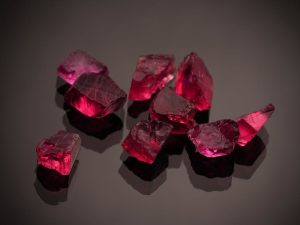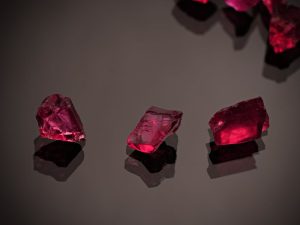Ruby, the birthstone of July, can cost from $3 to $23,000 per carat. Find out why.

Ruby must rate as one of the most popular gemstones. Almost every retail jewellery outlet will have on stock jewellery containing ruby and everybody knows what a ruby is. Or do they? Look at the cut stones featured above, each one is a ruby, and each is of a similar size and quality but their price can vary from $3 per carat to $25,000 per carat. Can you say why this is so? One is a synthetic and that makes it is easy to understand a $3 per carat price tag. However the rest are all cut from material mined from the earth and their prices vary from $50 per carat to $25,000 per carat. Can you say why? Can you tell which is which?
Most people think of rubies as coming to them from mines located in some foreign land, such as Burma, as rough material that is cut and polished and then set in jewellery. This may have been mostly the case some fifty years ago but these days almost all rubies are subjected to various treatment processes during processing. Some of these procedures are traditional and acceptable, some are very modern, quite high tech and to many members of our industry totally unacceptable. Naturally the degree of acceptance of these processes has an effect on value. In order of acceptability the following treatments are commonly applied to the rubies today:
Heat treatment: The colour of some ruby can be improved by the application of heat so as to drive out blue, purple and brown overtones resulting in a more pure red. This has been practiced for centuries and is considered acceptable. The treatment is permanent.
Heat treatment with flux: The application of heat results in improved colour and when done in conjunction with a glass like flux, cracks and fissures are filled and sealed in a similar manner to oiling emeralds. This process is used on most commercial ruby.
Heat treatment with flux & cavity infilling: Sometimes a rough stone will have cavities that are filled with the flux. When such a stone is cut and polished the flux filling in the previous cavity does not have to be ‘cut out’ resulting in a larger cut stone. Small flux filled cavities may be acceptable but large cavities are not.
Heat treatment with Beryllium: Less than ten years ago it was discovered that brownish red sapphire could be turned a bright red by heating at high temperatures in the presence of Beryllium. Rubies treated in this manner are generally considered to be of lesser value than those subjected to traditional heat treatment.
Low temperature glass filled: By applying high pressure at low temperature to certain types of ruby in the presence of a lead glass, the glass can be made to penetrate and fill large cracks and cavities. Some stones have been found to contain 20 to 30 percent glass leading international gemmological experts to now refer to such material as glass/corundum composites. This process has in recent times seen large apparently fine ruby entering the market at ever reducing prices. To many in the industry such stones should not be considered as ruby. The filling may deteriorate and is not considered permanent.
The ACCC, in their guidelines to the jewellery industry, states that all types of treatment must be declared at the point of sale. This applies to all the above treatments. Also, all other things being equal, untreated natural rubies sell for a premium over their treated counterparts. So can you tell the difference?
For further information visit The Gemmological Association of Australia’s website www.gem.org.au
